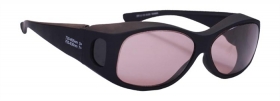Lasers emit a source of high-energy light, which can be focused to transmit light onto small areas. Medical lasers have been used in a variety of different applications and procedures for many years. They are used in many clinical, surgical, cosmetic, diagnostic and dermatologic procedures.
Laser Safety glasses are a primary safety requirement and should be worn at all times during laser procedures. It is a crucial that the operating laser and protective eyewear match. This post will highlight a few common lasers and their many applications in the medical arena.YAG Lasers (Nd:Yag and Er:Yag) are commonly used in the following medical procedures: eye surgeries, dentistry, skin restoration treatments, hair removal, orthopedic procedures and more. This type of laser produces short-pulsed and high-energy light beams giving the ability to cut, perforate and separate tissue. All Yag lasers can be operated in continuous/pulsed or Q-switched mode. Yag Laser Safety Glasses will keep your medical staff and patients protected during Yag laser applications.
CO2 Lasers (carbon dioxide lasers) are very useful in surgical procedures because biological tissue absorbs this frequency of light well. Some medical uses are skin resurfacing, dermabrasion, treatments of skin conditions, microsurgeries and more. It is important to make sure all your medical personnel are properly trained for using and working around high powered lasers. Accidents can easily take place without the appropriate training and education.
Diode Lasers are often used in dentistry and medical applications and have the ability to emit many different ranges of wavelengths. Common medical uses for the diode lasers are hair removal, skin rejuvenation, varicose vein removal, dental applications, treatments of macular degeneration and carpal tunnel syndrome, etc. Protective eyewear, like the Diode Safety Laser Glasses should be stored in a protective unit for safe keeping when they are not being used. Safety glasses dispensers will help keep glasses clean and organized.
Alexandrite Lasers are often used in cosmetic and dermatologic treatments also including fluorescence diagnostics. These lasers were developed to isolate and emit certain wavelengths of light to be used in a variety of medical and scientific purposes.
Your facility should be compliant with ANSI standards (Safe Use if Lasers in Health Care) and the U.S. Occupational Safety and Health Administration, both require staff to wear laser safety glasses or goggles when operating or around Class 3b and Class 4 lasers. These lasers can cause significant injuries to the eye, including partial/full loss of vision. There are many other important types of laser systems used in the medical setting and it is important to know the safety measures that are needed with each one. If you have any comments of questions, please let us know below!


Leave a Reply